Continuing with the series of Indiana golf courses. This time we venture a little north.
Warren Golf Course
South Bend, Indiana
Touchdown Jesus, golden domes and Knute Rockne are the things that most people associate with Notre Dame athletics. And make no mistake about it, football is king at the private Catholic institute of higher education location on the outskirts of South Bend, Indiana. Even with that, the university recognizes the importance of having other top-flight facilities around the campus other than the famed Notre Dame stadium, home of the several time national champions, and the Joyce Center, where the men’s and women’s basketball teams ply their trade. This excellence in academic facilities extends to the golf course as well. The Warren Golf Course is widely recognized as one of the top courses in the state and has received national recognition.
The routing of the course is delightful with several small loops that run out and back to the clubhouse, with each nine running over the more exciting terrain on the west end of the site at some point. Coore and Crenshaw also saved the more dramatic elevation changes for the finish of the round so as not to take away from the remainder of the course and to end on the best note. It is a fine exhibition of scholarly and clever design.
Along with this magnificient style of routing, the designers also referred back to their youth with old-fashioned green complexes that remind one of the Perry Maxwell courses that Coore and Crenshaw played earlier in their lives. Every green slopes from back to front and features a semi-false front. Scalloped edges around the green accent the internal contours of small and large humps similar to the famed “Maxwell rolls” developed in the first half of the twentieth century by the American architect. All day the player could be misreading putts because of the deceptive works of art.
The opening hole on the course.
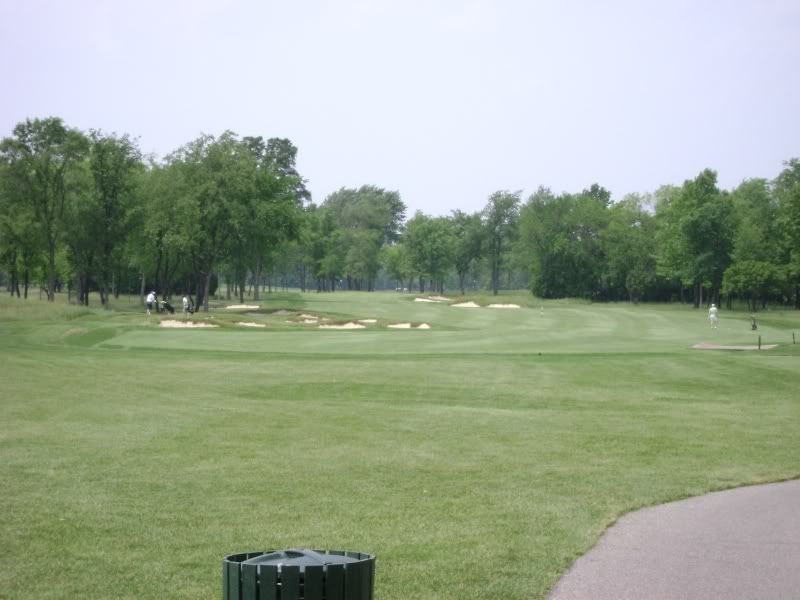
The bunkering on the course is also very reminiscent of the ragged edges used by the famed architects of the “golden age” of architecture. A unique take on the larger waste area bunkers is the number of bunker clusters composed of smaller and less intimidating sand features. But they have just as much bite as the larger versions, perhaps even more when one considers the thick rough that lies between each trap. The club has only added to this by adding hazards on several holes. That gets to the final point when one discusses the course. It is as difficult as any course you will find among the Indiana public courses. And this applies if it is played from the tips or the upper markers.
Holes of note:
Hole 2 – 462 yards – The rolling fairway runs with the dogleg from left to right. A wide fairway allows the player to swing away on the tee shot. A bunker some sixty yards short of the green hides the gap beyond for anyone on the right side of the fairway. The left side provides a clear view of the entire hole but adds length. The green has a slight false front, like most of the holes, and a steep slope from back to front.
The view from the right side towards the green.
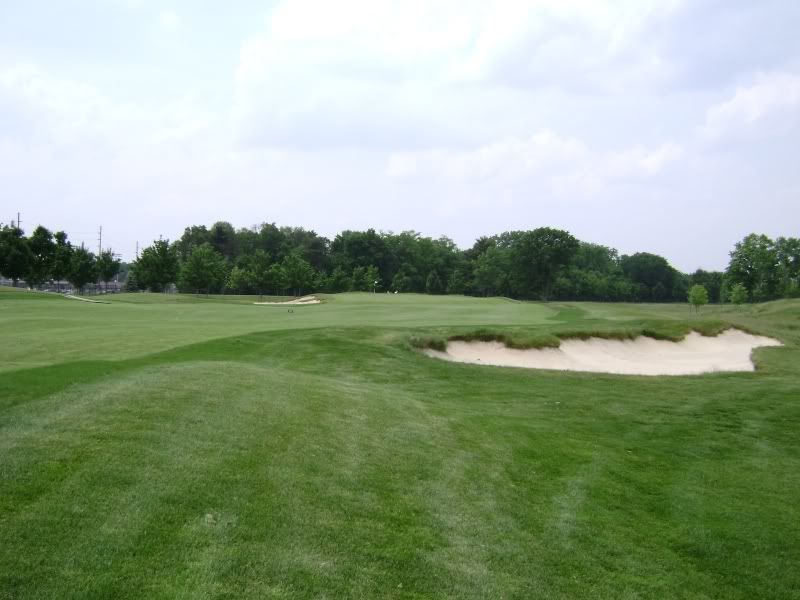
Hole 3 – 410 yards – The hole runs straightaway with the best angle really coming from the left side so the pond is less in play. A small plateau exists near the newly added bunker on that same side. The rest of the fairway runs slightly towards the pond and creates a slightly uneven lie.
The view from the third green to the fourth over the pond.
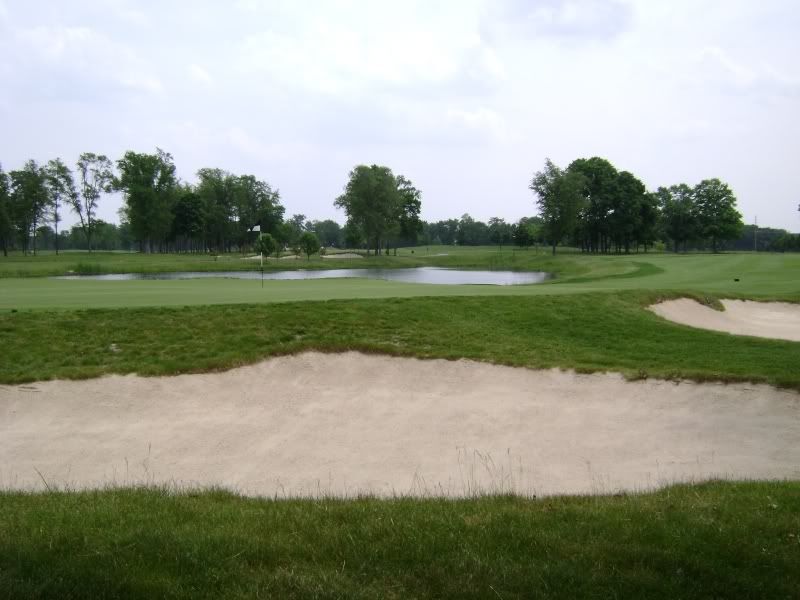
Hole 4 – 145 yards – The first par three on the course is a very short one by modern standards and brings back into play this classic style of hole. The green is protected on three sides by some of the deepest bunkers on the course. The green has contouring that is clearly visible from the tee, which never bodes well for the less than accurate ball, in the form of two large rolls. It is at this point that one really begins to get the feeling that they might be on an old-style Perry Maxwell course like Hillcrest or Muskogee.
The view from the tee.

Hole 5 – 518 yards – The only three-shotter on the front. It is most notable for the slightly horseshoe shaped green and the bunker in the center front. Again the designers are pulling from a traditional concept used by a golden-age designer.
The approach into the green
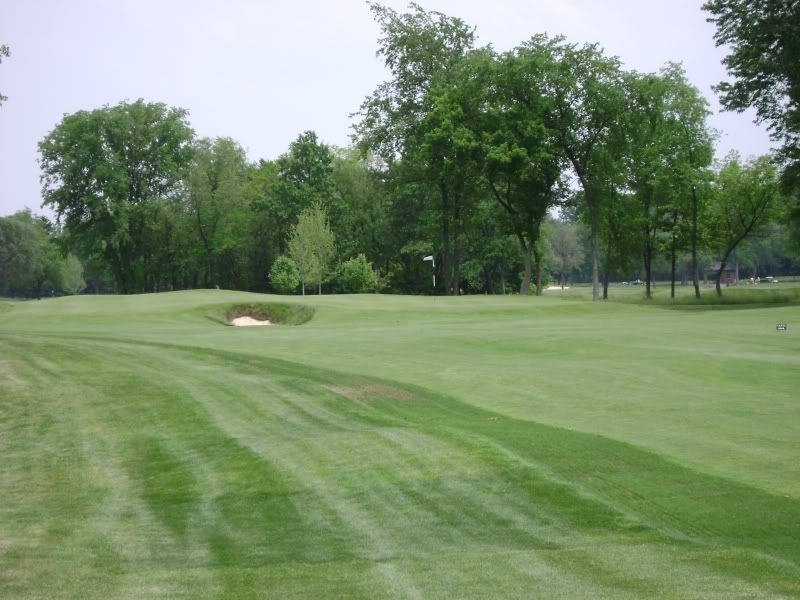
Hole 7 – 406 yards – From the tee the player must devise a way to get around the center line bunker that was recently put in by the club. The fairway is a bit wider to the right and thus increasing the length of this right to left dogleg that is presented beautifully from the tee with the green in the distance.
View from the tee with the center line bunker in play. I wonder if they ever thought of removing the two trees to the left and putting a bunker on that side instead...
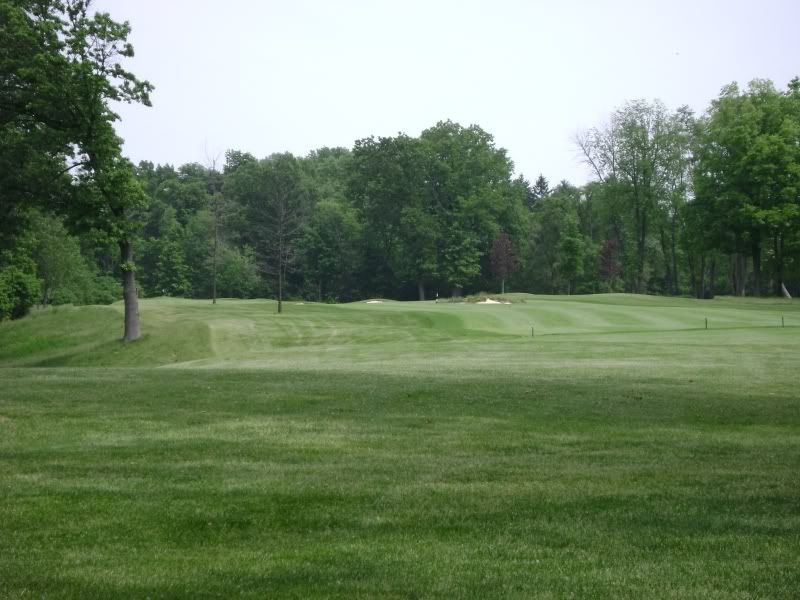
Hole 10 – 495 yards – A wonderful short par five that runs down hill with the fairway running from left to right for the longer hitters and creating a better angle into the green. The landing area short of the green is split diagonally by a stream and tempts the player to try and go for the target. A great risk-reward hole.
Looking across the stream short of the 10th green
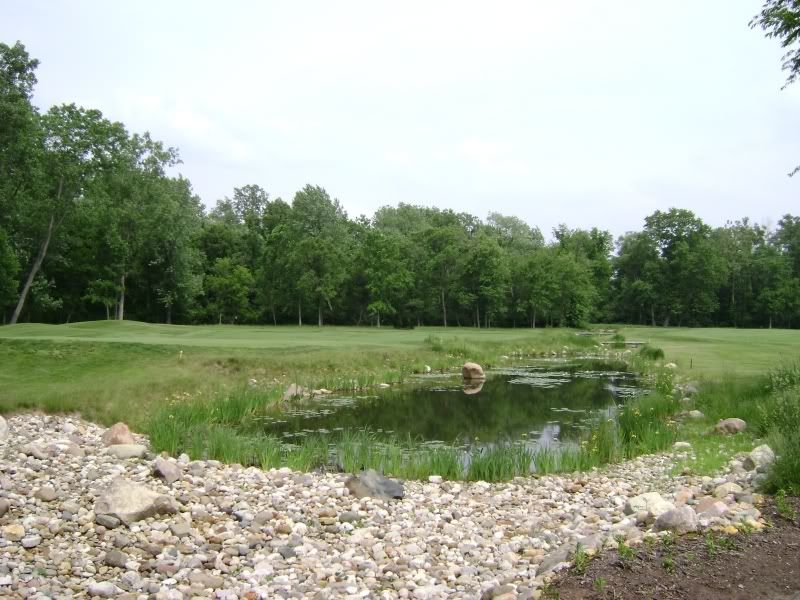
Hole 16 – 345 yards – A world-class short par four that is not drivable but presents many options to the player. A creek runs across the fairway with the longer carry being out to the right. The left side of the hole is protected by a series of bunkers that run up to the green in a stair like pattern. The right side is protected by a solitary bunker directly in front of the middle of the green. This bunker caused some serious damage in our group. What can not be stressed enough is how much this hole runs downhill from the tee and then back uphill to the green.
From the tee

The approach
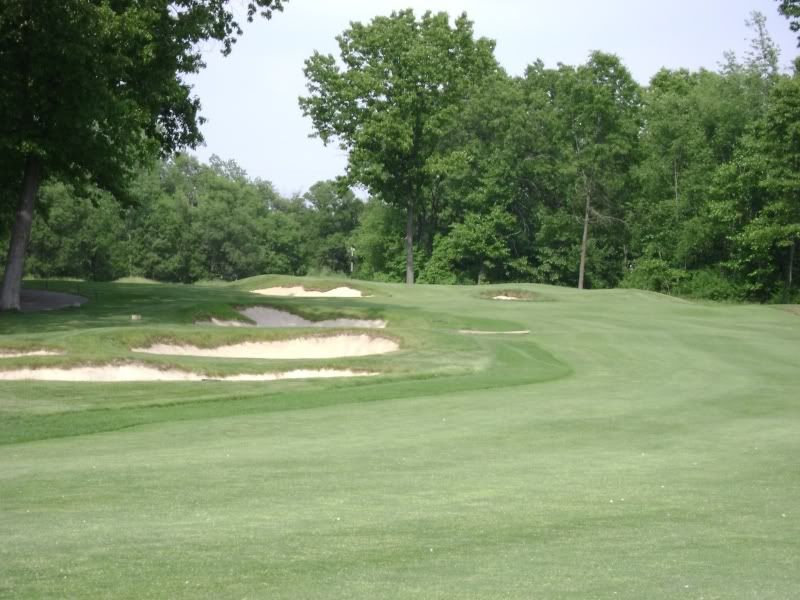
The side of the green
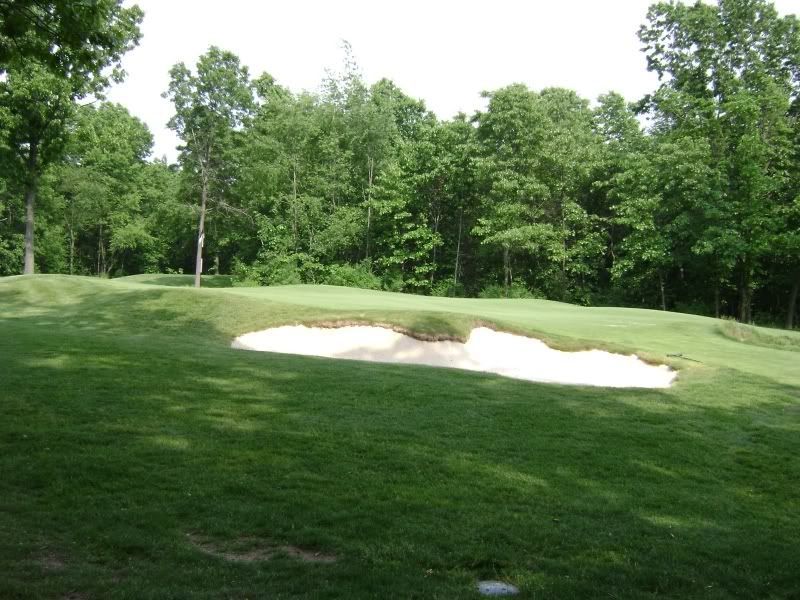
Hole 17 – 565 yards – Another stunner of a hole. The fairway doglegs from right to left along with the terrain running this way as one looks on from the elevated tee to the severely down hill fairway below. The drive seems to fly forever off of this tee if struck well. The second must run back up hill to the skyline green in the distance. Two bunkers border the fairway like sentinels, but really should only come into play if the first shot is poorly struck. The greenside bunker on the left is the deepest on the course and is to be avoided. I speak from experience.
View from the elevated tee
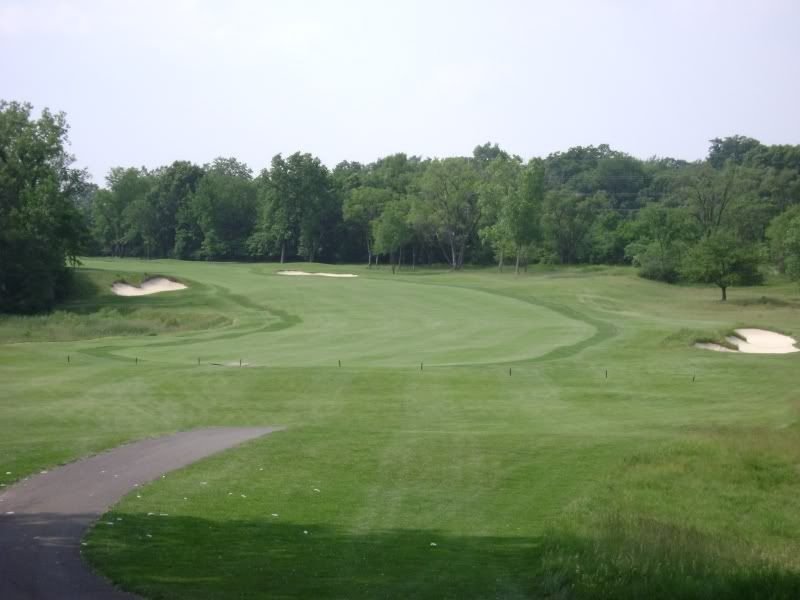
Hole 18 – 455 yards – The last hole features another elevated tee shot. The options from the tee are to carry the creek that crosses the hole or lay up and resign yourself to playing the hole as a three shotter. A solid tee shot leaves a long-iron into the green. Another tough green awaits.
The final tee with the creek crossing the fairway.
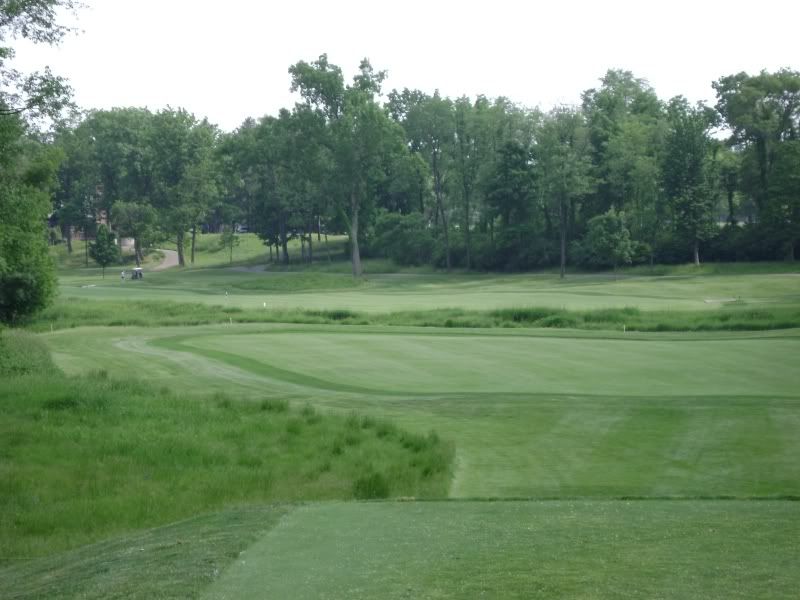
This finish is one of the best in the state, especially among public courses. Throughout the course there are glimpses of Ross, Mackenzie, Tillinghast and Maxwell. It provides a really old-style feel. In our round there were only two things that I noticed that could be a possible knock against the Warren Course. The course is being tightened as the rough was being grown in by a yard or two on each side on every hole. There also appeared to be some problems with poa on the greens which only affected the entrances with what we experienced in our round. But on the whole this should be one of the highlights of any trip to northern Indiana and one of the top courses in the state among the public venues.